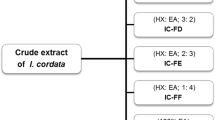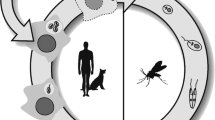Abstract
The present study reports on the in vitro antileishmanial activity of two Ircinidae (Dictyoceratida, Demospongiae, Porifera) Ircinia spinosula and Sarcotragus sp. Sampled from the east coast of Tunisia. The ethyl acetate, dichloromethane, and aqueous extracts were tested against Leishmania major promastigotes. The anti-proliferative activity was checked using different extracts concentration during 72 h. We found that the IC50 (sub-inhibitory concentration) values ranged from 1.39 to 264.67 μg/ml. The most active extract was that from sarcotragus sp dichloromethane extract. Microscopic observations showed that the extracts promoted cellular alterations and induce enlargement of the nucleus and modification of the parasite shape. These promising results in relation with in vitro antileishmanial activity open the way for complementary investigation in order to purify and identify active molecules.



Similar content being viewed by others
References
Ben Mustapha K, Chaouch M, Dhabi L, (2007) Mise à jour de la nomenclature des demosponges de Tunisie Bull. Inst. Natn. Scien. Tech. Mer de Salammbô 34:61–67.
Ben Mustapha K, El Abed A (2001) Les éponges en Tunisie; Resources exploitées ou a exploiter? 8éme journée sur les Acquis de la Recherche agronomique. (Iresa Min Agricultr Tun edit) Pp 8.
Ben Mustapha K, Zarrouk S, Souissi A, El Abed A (2003) Diversité des demosponges tunisiennes. Bull Inst Natn Scien Tech Mer de Salammbô 30:55–78
Bouaicha NP, Amade D, Puel C, Rouassakis (1994) Zarzissine, a new cytotoxic guanidine alkaloid from the Mediterranean sponge Anchinoe paupertas. J Nat Prod 57:1455–1457.
Choi K, Hong J, Lee C, Kim D, Sim C, Im K, Jung J (2004) Cytotoxic furanosesterterpenes from a marine sponge Psammocinia sp. J Nat Prod 67:1186–1189
Davis AJ, Murray HW, Handman E (2004) Drugs against leishmaniasis: a synergy of technology and partnerships. Trends Parasitol 20:73–76
Dhabi-Gafsi L (2007) Etude comparative des ircinidae des îles de Kerkennah et du cap bon (Spongiaires, Deosponges), Fac Des sciences-INSTM, (Univ tunis edit);, pp 115
Dedet J (1999) Traitement. In : les leishmanioses. Dedet, J.P., ED. AUPELF / UREF. Paris.
Desjeux P (2004) Leishmaniasis: current situation and new perspectives. Comp Immunol Microbiol Infect Dis 27:305–318
Dube A, Singh N, Saxena A, Lakshmi V (2007) Antileishmanial potential of a marine sponge, Haliclona exigua (Krikpatrick) against experimental visceral leishmaniasis. Parasitol Res 101(2):317–324
Faulkner DJ (2002) Marine natural products. Nat prod 19:1–48
Haouas N, Gorcii M, Chargui N, Aoun K, Bouratbine A, Messaadi Akrout F, Masmoudi A, Zili J, Ben Said M, Pratlong F, Dedet J-P, Mezhoud H, Azaiez R, Babba H (2007) Leishmaniasis in central and southern Tunisia: current geographical distribution of zymodemes. Parasite 14:239–246
Hentschel U, Schmid M, Wagner M, Fieseler L, Gernert C, Hacker J (2001) Isolation and phylogenetic analysis of bacteria with antimicrobial activities from the Mediterranean sponges Aplysina aerophoba and Aplysina cavernicola. FEMS Microbiol Ecol 35:305–312
Kayser O, Kiderlen A, Croft S (2003) Natural products as antiparasitic drugs. Parasitol Res 90:55–62
Le Pape P, Zidane M, Abdala H, More M (2000) A glycoprotein isolated from the sponge, Pachymatisma johnstonii, has antileishmanial activity. Cell Biol Int 24:51–56
Liu Y, Bae BH, Alam N, Hong J, Sim CJ, Lee C, Im KS, Jung JH (2001) New cytotoxic sesterterpenes from the sponge Sarcotragus species. J Nat prod 64:1301–1304
Martínez A, Robledo S, Muñoz D, Blair TS, Higuita DE, Echeverri PE (2001) Antiparasitic Activity of Methanol Extracts and Isolated Fractions from Caribbean Sponges. Vitae 8:71–81
Marchan E, Arrieche D, Henriquez W, Crescente O (2000) In vitro effect of an alkaloid isolated from Amphimedon viridis (Porifea) on promastigotes of Leishmania mexicana. Rev Biol Trop 48(Suppl):31–38
Munro MHG, Leibrand RT, Blunt JW (1987) The search for antiviral and anticancer compounds from marine organisms. In: Scheuer PJ (ed) Bioorganic Marine Chemistry 1. Springer Verlag, Heidelberg, pp 93–176
Nakao Y, Shiroiwa T, Murayama S, Matsunaga S, Goto Y, Matsumoto Y, Fusetani N (2004) Identification of renieramycin A as an antileishmanial substance in a marine sponge Neopetrosia sp. Marine Drugs 2:55–62
Pawlik JR, McFall G, Zea S (2002) Does the odor from sponges of the genus Ircinia protect them from fish predators? J Chem Ecol 28:1103–1115
Pratlong F, Rioux JA, Marty P, Faraut-Gambarelli F, Dereure J, Lanotte G, Dedet JP (2004) Isoenzymatic analysis of 712 strains of Leishmania infantum in the south of France and relationship of enzymatic polymorphism to clinical and epidemiological features. J Clin Microbiol 42:4077–4082
Rangel HR, Dagger F (1997) Antiproliferative effect of illimaquinone on Leishmania mexicana. Cell Biol Int 21:337–339
Rao KV, Santarsiero BD, Mesecar AD, Schinazi RF, Tekwani BL, Hamann MT (2003) New manzamine alkaloids with activity against infectious and tropical parasitic diseases from an Indonesian sponge. J Nat Prod 66:823–828
Rao KV, Kasanah N, Wahyuono S, Tekwani BL, Schinazi RF, Hamann MT (2004) Three new manzamine alkaloids from a common Indonesian sponge and their activity against infectious and tropical parasitic diseases. J Nat Prod 67:1314–1318
Shin J, Rho JR, Seo Y, Lee HS, Cho KW, Sim CJ (2001) Sarcotragins A and B, new sesterterpenoid alkaloids from the sponge Sarcotragus sp. Tet Lett 42:3005–3007
Souissi A (2003) Systématique et chémotaxonomie des démosponges (Porifera, demospongiae) du banc Hallouf. Fac Sciences Tunis-INSTM, (Univ tunis edit); Pp 113
Tiuman TS, Ueda-Nakamura T, Cortez DAG, Dias Filho BP, Morgado-Dı´az JA, De Souza W, Nakamura CV (2005) Antileishmanial activity of parthenolide, a sesquiterpene lactone isolated from Tanacetum parthenium. Antimi Ag Chemo 49:176–182
Touati I, Chaieb K, Bakhrouf A, Gaddour K (2007) Screening of antimicrobial activity of marine sponge extracts collected from Tunisian coast Criblage de l’activité antimicrobienne d’extraits d’éponges marines des Côtes tunisiennes. Journal de Mycologie Médicale 17:183–187
World Health Organization (WHO), 2002. Programme for the surveillance and control of leishmaniasis (http://www.who.int/emc/diseases/leish/index.html).
Yan HY (2004) Harvesting drugs from the seas and how Taiwan could contribute to this effort. Changhua J Med 9:1–6
Author information
Authors and Affiliations
Corresponding author
Rights and permissions
About this article
Cite this article
Ben Kahla-Nakbi, A., Haouas, N., El Ouaer, A. et al. Screening of antileishmanial activity from marine sponge extracts collected off the Tunisian coast. Parasitol Res 106, 1281–1286 (2010). https://doi.org/10.1007/s00436-010-1818-x
Received:
Accepted:
Published:
Issue Date:
DOI: https://doi.org/10.1007/s00436-010-1818-x




